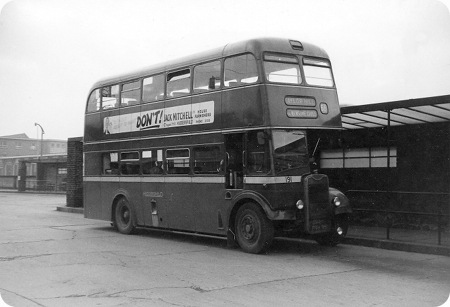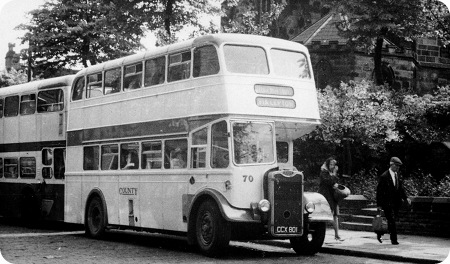Huddersfield Corporation – Guy Arab IV – PVH 991 – 191
Huddersfield Corporation
1959
Guy Arab IV
East Lancs H37/28R
This bus looked very dated for its actual age if you think about it most Arab IVs had the ‘Birmingham tin fronts’ as they were called which looked more modern. The Leyland Titan on the other hand could get away with the exposed radiator look probably because there was a bit more to it than the narrow un-shiny Guy version depicted here.
This bus passed to W.Y.P.T.E. on the 1st of April 1974 and became fleet number 4191 and no doubt was painted there green and white, which was OK when clean but terrible when dirty, which most of there buses were for about 90% of the time.
W.Y.P.T.E. stands for ‘West Yorkshire Passenger Transport Executive’
———
Huddersfield only had two of these Arab VIs this one and its sister, registration number PVH 990 fleet number 190 they both had Gardner 6LX 10.45 litre six cylinder engines.
Spencer
———
Two really excellent buses, the 6LX gave them hill flattening performance, really desperate shame Guy decided to throw all it’s eggs in the Wulfrunian basket which along with the Warrior truck had them bankrupt, the GUY Big J was designed to be a Daimler truck and this kept the factory going but this model was gone and by the time sense returned it was too late, a last flourish with the Mark V was too late as rear engines and one manning were to be the way forward.
Christopher
———
I couldn’t be 100% certain, but I don’t think either of these fine machines were painted into "buttermilk and emerald" by the PTE. I also seem to remember that they had two pedal semi automatic transmission as opposed to the more normal Guy clutch and gearbox system – can anyone remember for certain ??
Chris Youhill
———
Yes, they were definitely semi-automatic. Huddersfield had no double-deckers with manual gearboxes at all.
Peter Williamson
———
27/04/11 – 07:37
I had the pleasure of driving 191 during it’s short preservation career. I can confirm it was, as Peter says, a semi-automatic gearbox which had a very bad transmission oil leak. Apparently 190 had also suffered from this malady during its service days and the gearbox had been replaced by a one from a Daimler CVG6LX using a Leyland PD2 prop-shaft! Neither 190 or 191 received PTE livery both remaining in the later simplified Corporation livery. Sadly 191 was sold for scrap due to storage and other difficulties.
Eric
———
27/04/11 – 18:07
Guy’s original problem, Christopher, was its ill-judged entry into financing vehicles sold on the HP in South Africa, rather than merely selling vehicles through local agents, as previously. This strained its finances at the very time the Wulfrunian’s lack of development/testing came to the fore, and then going under. It did fairly well under Jaguar control, but was never going to get the support it deserved with the dominant part of British Leyland. It certainly never got any money to modernise and continue to produce its excellent vehicles at competitive cost, hence it was shut down.
But it was the self-inflicted South African venture which initially sealed its fate, sad to say. The Wulfrunian was an aberration: usually its vehicles were well-designed, well-built and well-tested before being released to buyers. A good example is when London Transport first took delivery of its somewhat troublesome austerity Guy Arabs – Guy actually sent many of its engineers to London and even told them to ride on its buses to identify problems and iron out the problems! They were soon sorted!
As an amusing side-issue, when Guy improved its gearboxes on later austerity Guys, it finally changed the gate from the reversed way (that is with first & second to the right and third and fourth to the left, London Transport was faced with confused drivers where both types were based at the same garage. It chopped a couple of inches off the new model’s gear levers; a satisfactory solution, it seems. But I digress!
Chris Hebbron
Quick links to the - Comments Page - Contact Page - Home Page



